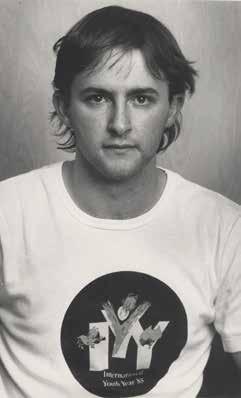
3 minute read
Dublin Calling: Albo’s Irish punk past
D U B L I N
ALBO’S IRISH PUNK PAST
Advertisement
BY LLOYD GORMAN
CALLING
Dublin 1988. Photo: E.A. Kennedy/BrandNewRetro.ie
A hip Anthony Albanese.
In 1988 as Dublin celebrated a thousand years since its foundation as a Viking settlement the city’s underground music scene was a swarm of rowdy and raw punk rock energy - and a young Anthony Albanese was there in the thick of it. In fact it is exactly thirty four years ago this month since ‘Albo’ – then 25 – was at large and on the loose in Dublin. At the time the Irish capital was a very different place to the metropolis and tourist mecca it is today. Alan Parkers’ hit film The Commitments was released in 1991 – but based on the 1987 Roddy Doyle novel of the same name – and captured that sense of the city on the brink of the economic revival that became known as the Celtic Tiger. High unemployment saw long queues at dole offices, urban decay meant many buildings in and around the city centre were falling down or boarded up and a heroin epidemic swept through the community. The young Aussie may have only been passing through but he was there long enough to sample

some of the subversive punk counter culture that kicked back against to this grim environment. He might have been a man about town every night of the week but what we do know for sure – thanks to Albo himself – is that he attended at least one punk gig there and it just so happens that it was some of his fellow countrymen. “Heading to the Factory Theatre [Sydney] tonight for #CelibateRifles - found this photo from Dublin 1988 #flashbackfriday,” he tweeted in December 2014. The Celibate Rifles* were a punk rock band from Sydney formed in 1979 while they were still at high school. The group’s name was their take on their English counterparts, the most famous Punk group ever, the Sex Pistols. They played Dublin in August 1988 and you’d have to image the like-minded Aussie boys who were all about the same age and from a similar background would have met each other or even enjoyed a drink before or after the Dublin gig. Like the Irish, Australians are usually keen to have a yarn with their own kind whenever their paths cross, and the more exotic the location the more that is true. The photo has one tell-tale that places him fair and square in Dublin. The logo and some of the writing on the side of the bus are blocked by the young smiling man. But many readers might recognise it as the logo for Dublin Bus, a part of CIE. In fact this logo was introduced just the year before. In case you’re interested the design is based on the 13th century Dublin seal depicting a castle of three watch towers surrounding one of the gates in the city’s medieval wall. The ‘Dublin Bus’ photo has even played a small part in his journey to become Prime Minister. Five years after he rediscovered the photo he dusted it off and used it as part of his bid to become the leader of the Australian Labor Party after the party – then headed by Bill Shorten – failed to defeat the Morrison government at the 2019 federal election. That post attracted a comment from none other than The Celibate Rifles themselves on May 27, 2019. “Well he seems to have reasonable taste in music,” they said about the image of him as a t-shirted youth. A few months later he posted it again when the bands enigmatic front man Damien Lovelock died at the age of 65. Thanks to one posting of the image we even have an idea of when and for how long Albo was in Dublin. Lindy Morrison, who was the drummer with the Australian indie-rock group the Go-Betweens (1980 to 1989) was slightly miffed by the inoffensive picture. “Humph. So you didn’t have a Go Betweens tee then?,” she messaged. He responded: “I did actually Lindy, but you weren’t playing in Dublin in July/August 88”. So we know something about when he was there and even a little about what he did but why he was there is not yet clear. It could be that like generations of Australians before and after him he was a backpacker on an overseas adventure that included a stop in Ireland. But is it possible the visit was motivated by something else? Might he have been there to meet or find relatives?










